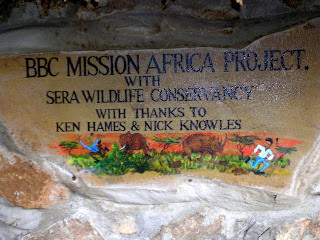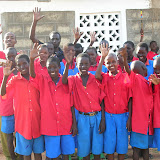
I find it daunting, the challenge of giving an overview of Samburu culture, with its varied and interconnected customs...Especially as they begin now to evolve at a rate far quicker than ever before. That being said, let's jump right in...
A Place to Call Home
The Samburu tribe lives in Northeastern Kenya, just above the equator in the Rift Valley Province (
See Map). The tribe generally set up homes in small encampments (8-10 families) located in the valleys and mountains of a 4,500 square mile area which surrounds two villages: Sereolipi and Ndonyo Wasin. The Samburu are generally classified as semi-nomadic pastoralists. Once the grass is gone, they will pick up and move in search of land better suited for grazing.
Two Towns: The Modern & The Bush
Sereolipi is the epicenter of "modern" Samburu life. The people I meet there are quick to tell me that Sereolipi is "a modern town" and they talk about the "bush village of Ndonyo Wasin." Sereolipi got its jump start in the mid-seventies, when a bridge was built over a mostly dried and silted riverbed, allowing trucks carry supplies to other villages farther north. First it was a truck stop. Around this the village grew.
Approximately 800 families live here, adding up to about 5,000 residents. The vast majority of residents live in the Samburu "manyatta" (below) and keep their livestock (goats and cattle and recently camels) in pen they construct from thorn tree bushes. The most affluent members of the community, three or four families, live in cement houses.
It is hard to see Sereolipi as the modern town that the Samburu describe. The largest institution in town, ten times over, is the school. After that, there is a tiny Christian church (leftovers from the missionary push), no electricity, no running water, no phone lies, no cell phone reception, no postal service, approximately 4 shops selling basic provisions, one bar (and extension of someone's living room) and many warriors is full regalia making their way up and down the dusty paths.
Main Street in Sereolipi
So what about
Ndonyo Wasin, the "bush village" the Samburu talk about in nostalgic tones of bygone days? Ndonyo Wasin is the "other Samburu town" and is located exactly a marathon (26 miles) deeper into the mountains, on a path that loosely resembles a road. To my untrained eye it looks and functions much the same as Sereolipi. The residents live in manyattas and keep their livestock with thorn trees. However, Ndonyo Wasin is certainly more remote and often residents traveling into Sereolipi leave at 4 AM, to avoid the midday heat. They travel in packs and speak or sing loudly to one another, so as not be a surprise presence to elephants and lions. (More on Ndonyo Wasin when I go to visit my mentee's family, who live there.)
The Manyatta
Almost all of Sereolipi's residents live in the Samburu hut called a manyatta. To match the nomadic lifestyle, there huts are made to move, constructed from sticks and twine and with a thatched hut roof. Manyattas have either dried cowskins or simply dirt for floors. Often residents do not have a bed (although my mentee does). Other things you will find in a Manyatta include: a small fire pit for cooking, a traditional Samburu school for blessings, a plastic bin for washing, and some decorative cloth.
It is the Samburu women who build the manyattas. In Samburu culture, a wife must build the hut for her husband. If a man is not married, he must employ a woman to build the hut for him (approximately $60 US). Often, all family members will sleep together in a single manyatta, the mother and father on the floor with their children. There are only a few key exceptions (below).
You can tell a Samburu family on the move to greener pastures by the roll of sticks tied to women's backs...The manyatta they have taken apart and will reassemble the next time they find home.
A Moveable Feast
Dine with the Samburu and you begin to get an idea of how their long history shows itself on the plate.
The most prominent fixture in any household is tea (British colonialism) served in a plastic Thermos. It is customary that tea must be served to all visiting guests, each time a new person arrives, even if he has simply crossed the street. I average about 8-10 cups a day during my stay. Tea in Sereolipi is heavily loaded with sugar (to ward of hunger pains) and there is also a special Samburu Tea with added chai.
Samburu Kitchen

Meals vary little from day to day. Breakfast is often just tea, but it can also include a porridge made from mealy-meal or some nan cooked on an open flame (Nan is the Kenyan carb-staple, Somali influences here).
Lunch is a stew of potatoes and sometimes meat (usually goat) over rice or mealy-meal ground into a consistency halfway between bread and mashed potatoes.
Dinner is the same.
Note: The Samburu love their livestock, they take care of their animals with craft and concern and relish in the meals that contain them. A favorite Samburu joke is when a group of men slaughter a goat and go off into the bush for a "meating."
The Birds & The Bees
Gender relations are one of the most complicated and conflicted aspects of Samburu culture. The customs follow a more or less traditional patriarchy: a man of marrying age (15 years after circumcision) can choose any woman to be his wife. There is no age regulation here and the stories, at their worst, include 70 year-old men marrying girls of 13, the girl of 13 coming on as a third wife. Additionally, although there is no divorce, a wife can be "returned" and a marriage annulled if she fails to produce a male child within the first year. The female's father is paid a dowry for his daughter (usually 5-8 cows). Wifes are responsible for building and keeping the Samburu hut, cooking meals and taking care of dishes and laundry. Children are responsible for grazing and tending to the livestock. Men are responsible for protecting the family (
Reminder: this is a culture of warriors who have only recently stepped down from war).
Men and women do not eat meals together and cannot show affection in public. It is, obviously, tough to find the romance in these relationships and I find myself wondering what they are like behind closed doors. In many families, there is obviously affection. There are times when you can feel it repressed in your presence.
Age SetsAge sets determine the roles and responsibilities for the male Samburu and are designed to benefit the community at large. A quick run down would go like this:
- Herders (Under 18): Samburu children are in charge of taking care of the families livestock. Taking goats and cattle out to graze consumes most of their day, every day, and Samburu children begin working with the animals as early as the ago of 5. Initially, and in many cases still, this was the single large roadblock to education in Sereolipi. Parents could not release their children to school because it would leave no one to take care of the livestock. This is a conflict the community is still addressing.
- Warriors (18-30): Although there is no set age for the transition (it is at the father's digression to choose), Samburu males go off for circumcision around the age of 18 or 20. Circumcision is an important ritual for the Samburu, as it is in many African cultures, signifying the point in life where each boy becomes a man. Boys march off into the bush in groups of 10 or 15, where they meet a traditional healer who performs the circumcision with a spear (two other relatives or appointed friends hold the back and legs of each boy during circumcision). When the boys return, now as men, they take on an entirely different role in the community. Now they are warriors and must wait 15 years until they can marry. During that period they are in charge of protecting all Samburu people. They begin to wear the traditional Samburu attire. They can no longer live in their family's manyatta. They cannot eat any food cooked by Samburu women (until they are married) and must not be seen eating by women at all.
- Junior Elders (After Marriage): After a Samburu marries, he becomes a junior elder and becomes a part of the large decision making consensus groups which rule over all important community decisions.
- Elder (50-60): The Elders are a highly respected faction in the Samburu culture and are called upon to make important decisions is personal and community matters. There are usually between 100-200 elders in the Samburu tribe at any given time.
On English
Of Sereolipi's 5,000 residents, about 20 are fluent in English and the oldest English speaker is the village chief, who is 45. This is a challenge for a school where all classes and qualifying exams are given in English. (Many students at the school are the first members of their family who can write their name.) It will be a significant marker between the younger and older generations currently living in Sereolipi.
__________________________________________________________Much more on Sereolipi, Samburu and the evolution of education and technology in the bush... coming soon...
 Starting this winter, iMentor will begin connecting students from two remote villages in Kenya with American mentors.
Starting this winter, iMentor will begin connecting students from two remote villages in Kenya with American mentors.
















































